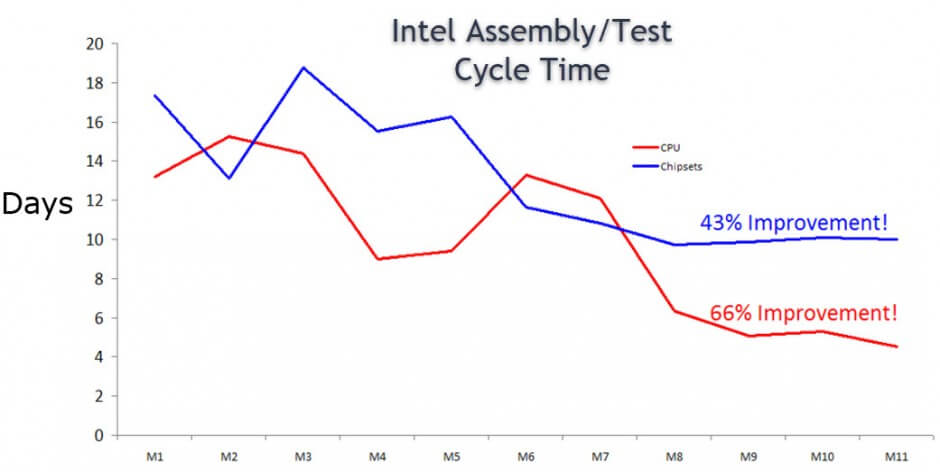“‘Eliminate Waste’ is a nonsensical slogan.1” – Shigeo Shingo
Performance improvement strategies that revolve around the notion of reducing non-value-added activities continue to be popular. Unfortunately for the multitudes of companies relying on them, these strategies are seriously flawed and often result in huge wastes of time and effort.
The “value-added” focus is one of legions of corporate slogans and consulting initiatives, e.g. “one-piece flow,” “eliminate waste,” “zero variability,” and “big data.” Why do these initiatives seldom live up expectations? Because they don’t offer a practical, scientific method of determining which activities have a meaningful impact on performance.
Specifically, the value-added fantasy is the perception that concentrating on “value-added” activities and eliminating non-value-added activities will provide the most profitable performance for a company. If companies really want sustainable, profitable performance, they should abandon the value-added fantasy and instead focus on a practical, scientific approach to quantifying and controlling the elements of cycle time that drive profit. We define cycle time as the time to complete a routing or value-stream. Other names for cycle time include throughput time and flow time. A practical, scientific focus on cycle time can lead to a structured, objective, and predictive approach to improving profitability.
A value-added strategy may or may not lead to improved profitability. So why risk your career on something so risky? You may be asking, “If value-added strategies don’t really work, why are they so popular?” To answer that, let’s first look at some typical definitions of value-added:
Some good things can result from value-added analysis. For instance, it typically shows that most of a product’s cycle time is spent waiting. Many companies, especially those where little process improvement has been done, have gotten great initial benefit from this identification of wait time. They have been able to eliminate some of this wait—or wasted—time. Additionally, the value-added concept is a simple concept—eliminate waste, focus only on activities that provide value. Simplicity in management slogans is a great driver of popularity of the slogans and rightly so. However there are problems with the value-added fantasy, particularly the notion that it addresses things customers care about. Sometimes a solution that is too simple is a problem, especially with real world processes and challenges.
In the vast majority of cases, assuming a company is not using slave labor or other unethical practices, the customer does not care what a company does in its processes. The customer makes a value statement with an exchange of money for goods or services at the time of purchase of a product or service. When purchasing gas for our cars, not once have we considered the value-added vs. non-value-added activities that might be taking place at the refineries—sad but true.
How do you think the majority of your customers would respond to following survey question?
A. I prefer companies that have long setup times
B. I prefer companies that have short setups times
C. I am not concerned about companies’ setup times
We believe the answer “C” would win hands down.
Since the vast majority of customers are not concerned about the activities that go on within a company’s  production or service processes, having internal process improvement discussions2 about what customers consider to be value-added or non-value-added is an extremely subjective and often dysfunctional exercise. Actually, since “value-added” is typically defined as a process step that changes form, fit or function, the value-added steps are the ones that a company would need to do most effectively whether a customer knows about them or not. Calling these steps value-added is just a confounding classification and frequently leads to non-productive discussions (see photo). For instance, try telling an accountant or a highly-skilled quality inspector that their job is non-value-added. The use of vague terms such as non-value-added leads to the creation of more vague terms, thus the invention of the term “necessary non-value-added”—still not an inspirational label for those folks that are necessary but non-value-added.
production or service processes, having internal process improvement discussions2 about what customers consider to be value-added or non-value-added is an extremely subjective and often dysfunctional exercise. Actually, since “value-added” is typically defined as a process step that changes form, fit or function, the value-added steps are the ones that a company would need to do most effectively whether a customer knows about them or not. Calling these steps value-added is just a confounding classification and frequently leads to non-productive discussions (see photo). For instance, try telling an accountant or a highly-skilled quality inspector that their job is non-value-added. The use of vague terms such as non-value-added leads to the creation of more vague terms, thus the invention of the term “necessary non-value-added”—still not an inspirational label for those folks that are necessary but non-value-added.
In Factory Physics for Managers we describe many practical, scientific approaches to understanding and improving cycle time. The concepts in Factory Physics for Managers provide much more reliable means of achieving consistent performance improvement than the value-added approach. The statement:
Cycle Time = Value-added time + Non-value-added time + Necessary non-value added time
does not provide useful information about where to address the most profitable efforts for improving performance. The statement is true though it is like saying, “It will rain today or it will not rain today.” The division of cycle time into elements related to value-added steps provides no predictive control about what will happen to an organization’s financial performance if the various elements are addressed.
Eliminate unproductive efforts fueled by subjective definitions. Control your operations’ performance using the practical science that describes the natural behavior of your operations. A fundamental, comprehensive framework of operations science shows that cycle time is composed of the following components:
Now this is not as simple a list as value-added, non-value-added and necessary non-value-added, but it is a much more powerful classification of the elements of cycle time.
Why? First, every item in the list can be described quantitatively and objectively and the list completely describes the elements of cycle time. Second, because the description is quantitative and objective, its use provides predictive control over performance.
For example:

Do not waste time with subjective “value-added” attempts to drive performance of your organization. You might get good results but then again, you might not. Drive your career progression and strengthen your company’s financial health through a solid understanding of the practical science that provides predictive descriptions of the interactions between WIP, throughput, cycle time, variability and cost. Contact Factory Physics Inc. to find out how.
1 Shingo, Shigeo, The Sayings of Shigeo Shingo: Key Strategies for Plant Improvement, 1987, Productivity Press, 19.
2 Of course, considering what the customer values is paramount when dealing directly with a customer. We are referring to application of the criteria to decisions about internal processes that are not directly at the customer interface
Factory Physics Inc. is a software and management consulting company that provides a scientific framework, software, and training to increase profitability and performance of manufacturing supply chains. Factory Physics principles and applications provide executives and managers the practical science to cut through complexity, reduce conflict and establish predictive control. The result is accelerated performance and profitability of manufacturing supply chains. Factory Physics Inc. is the world leader in operations science applications. For more information, contact Ed Pound at espound@factoryphysics.com or by phone at 979.846.7828 x 151.
 Ed and Mark are co-authors, along with Jeff Bell, of the book Factory Physics for Managers. They work with companies around the world to apply Factory Physics concepts to make operations management easier and improve profitability, inventory and service.
Ed and Mark are co-authors, along with Jeff Bell, of the book Factory Physics for Managers. They work with companies around the world to apply Factory Physics concepts to make operations management easier and improve profitability, inventory and service.
FACTORY PHYSICS® and LEANPHYSICS® are registered trademarks of Factory Physics Inc.